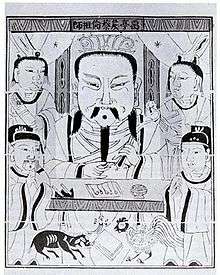Cai Lun
| Cai Lun | |||||||||||||||||||||||
|---|---|---|---|---|---|---|---|---|---|---|---|---|---|---|---|---|---|---|---|---|---|---|---|
 An 18th-century Qing dynasty print depicting Cai Lun as the patron of paper making | |||||||||||||||||||||||
| Born |
48 Guiyang (today Leiyang), China | ||||||||||||||||||||||
| Died |
121 (aged 73) Han Palace of Luoyang, now Luoyang, Henan Province, China | ||||||||||||||||||||||
| Chinese name | |||||||||||||||||||||||
| Traditional Chinese | 蔡倫 | ||||||||||||||||||||||
| Simplified Chinese | 蔡伦 | ||||||||||||||||||||||
| |||||||||||||||||||||||
Cai Lun ([tsʰâi̯ lu̯ə̌n]; Chinese: 蔡倫; AD 48– 121), courtesy name Jingzhong (敬仲), was a Han dynasty Chinese eunuch and official. He is traditionally regarded as the inventor of paper and the papermaking process, in forms recognizable in modern times as paper (as opposed to papyrus). Although early forms of paper had existed in China since the 2nd century BC,[1] he was responsible for the first significant improvement and standardization of paper-making by adding essential new materials into its composition.[2]
Invention of paper
Cai Lun (蔡伦) was born in Guiyang (modern day Leiyang, Hunan) during the Eastern Han Dynasty. After castration followed by serving as a court eunuch from AD 75, he was given several promotions under the rule of Emperor He of Han. In AD 89 he was promoted with the title of Shang Fang Si, an office in charge of manufacturing instruments and weapons; he also became a Regular Palace Attendant (中常侍).[3] He was involved in palace intrigue as a supporter of Empress Dou, and in the death of her romantic rival, Consort Song.[4] After the death of Empress Dou in AD 97, he became an associate of Consort Deng Sui.
In A.D. 105, Cai invented the composition for paper along with the papermaking process—though he may have been credited with an invention of someone from a lower class.[5] There is also a legend that says Cai received inspiration for making paper from watching paper wasps make their nests. Tools and machinery of papermaking in modern times may be more complex, but they still employ the ancient technique of felted sheets of fiber suspended in water, draining of the water, and then drying into a thin matted sheet.[6] For this invention Cai would be world-renowned posthumously, and even in his own time he was given recognition for his invention. A part of his official biography written later in China read thus (Wade–Giles spelling):
In ancient times writings and inscriptions were generally made on tablets of bamboo or on pieces of silk called chih. But silk being costly and bamboo heavy, they were not convenient to use. Tshai Lun [Cai Lun] then initiated the idea of making paper from the bark of trees, remnants of hemp, rags of cloth, and fishing nets. He submitted the process to the emperor in the first year of Yuan-Hsing [+105] and received praise for his ability. From this time, paper has been in use everywhere and is universally called 'the paper of Marquis Tshai'.[3]
As listed above, the papermaking process included the use of materials like bark, hemp, silk, and fishing net; his exact formula has been lost. Emperor He was pleased with the invention and granted Cai an aristocratic title and great wealth.
In 121, Consort Song's grandson Emperor An of Han assumed power after Empress Deng's death and Cai was ordered to report to prison. Before he was to report, he committed suicide by drinking poison after taking a bath and dressing in fine silk robes.[7] Cai was later revered in Chinese ancestor worship. Fei Zhu of the later Song Dynasty (960-1279) wrote that a temple in honor of Cai Lun had been erected in Chengdu, where several hundred families involved in the papermaking industry traveled five miles (8 km) from the south to come and pay respects.[8]
Influence
The creator of this extremely important invention is only somewhat known outside East Asia. After Cai invented the papermaking process in 105, it became widely used as a writing medium in China by the 3rd century.[6] It enabled China to develop its civilization (through widespread literature and literacy) much faster than it had with earlier writing materials (primarily bamboo and silk, the latter of which was a more expensive medium).
By the 7th century, China's papermaking technique had spread to Korea, Vietnam, and Japan.[9] In 751, some Chinese paper makers were captured by Arabs after Tang troops were defeated in the Battle of Talas River. The techniques of papermaking then spread to the West. When paper was first introduced to Europe in the 12th century, it gradually revolutionized the manner in which written communication could be spread from region to region. Along with contact between Arabs and Europeans during the Crusades (with the essential recovery of ancient Greek written classics), the widespread use of paper aided the foundation of the Scholastic Age in Europe.
Notes
- ↑ Needham 1985, pp. 38–40
- ↑ Needham 1985, p. 41
- 1 2 Needham 1985, p. 40
- ↑ Peterson, Barbara Bennett, ed. (2000). Notable women of China: Shang dynasty to the early twentieth century. M. E. Sharpe. p. 105.
- ↑ Carter, Thomas Francis (1955). "The Invention of Printing in China and Its Spread Westward". Artibus Asiae Publishers: 187.
- 1 2 Needham 1985, p. 1
- ↑ Will Durant, The Story of Civilization: Our Oriental Heritage, Chapter XXV-The Age of the Artists, part 2 (The Revival of Learning)
- ↑ Needham 1985, p. 47
- ↑ Deng, Yinke (2005). Ancient Chinese Inventions. China Intercontinental Press. p. 21.
References
| Wikimedia Commons has media related to Cai Lun. |
- Tsien, Tsuen-Hsuin; Needham, Joseph (1985). Science and Civilization in China: Volume 5: Chemistry and Chemical Technology, Part 1: Paper and Printing. Cambridge University Press. ISBN 0-521-08690-6.